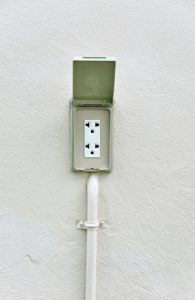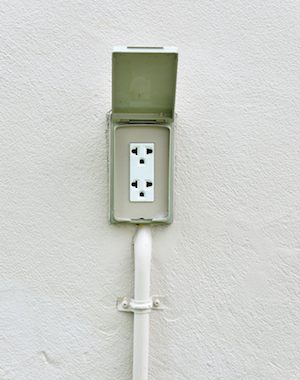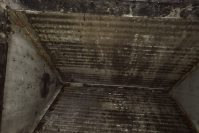 Outdoor electrical receptacles are very convenient. At Jeremy Services, we get calls to add outdoor receptacles quite often. Since this is a popular addition in the Overland Park and general Kansas City area, we thought we would share a little information that may come in handy whether you’re a DIY kind of homeowner or just considering having some outdoor outlets installed.
Outdoor electrical receptacles are very convenient. At Jeremy Services, we get calls to add outdoor receptacles quite often. Since this is a popular addition in the Overland Park and general Kansas City area, we thought we would share a little information that may come in handy whether you’re a DIY kind of homeowner or just considering having some outdoor outlets installed.
Outdoor Outlets Are Convenient
You may not realize it, but by code, homes only require one outdoor outlet in the front and one in the back of the home. Most times of the year, one outlet and some extension cords will suffice for hedge trimmers, cleaning the car with a shop vac or even outdoor entertainment in the form of music. But there’s one time of year when outdoor outlets become high priority – the holidays. Adding an outlet or two in the eaves is a super convenient option when it comes to hanging holiday lighting. Many yard decorations also require extra outlets. Plus, with outdoor living becoming more and more popular, stringing lights, adding music and serving food can all be a lot easier with more outdoor outlets to use.
GFCI Protection Is Important for Outdoor Receptacles
Outdoor outlets are exposed to rain, wind, temperature extremes and more. All of these conditions make outdoor outlets more likely to fail than indoor outlets. Exposure is also why outdoor outlets must be GFCI protected. Ground Fault Circuit Interrupters or GFCIs are outlets with test and reset buttons. The GFCIs are installed in areas where the potential hazards for electrical shock are exceedingly great (bathrooms, laundry rooms, kitchens, garages, basements, and outdoors.) They detect any leaks in the current and immediately shut off power supply in one thirtieth of a second. Standard outlets are sometimes connected to a GFCI outlet. This means that even standard outlets will no longer work after a GFCI shuts down power. All GFCI protected outlets are expected to be labeled but outdoor labels often fall off.
Rules for Outdoor Receptacles
All electrical work requires that you follow a code. This ensures the safety of any building with electricity. When it comes to outdoor receptacles, there are some special rules that must be followed. Here are some of the rules that apply:
- All 15-amp and 20-amp, 120-volt receptacles must be GFCI protected.
- A receptacle is required at the front and back door outside every home. This receptacle can be mounted no higher than 6’6″ above grade.
- A receptacle is required within the perimeter of each balcony, deck, or porch with a usable area of 20 square feet or more that is accessible from the inside of the home. Also, this can be mounted no higher than 6’6″ above grade.
- All balconies, decks, and porches that are accessible from the inside of the home must have a receptacle installed within their perimeter (with the exception of small areas).
- A light switch is required on the exterior in order to illuminate all entrances used by people.
- All 15- and 20-amp 120- and 240-volt nonlocking receptacles in wet or damp locations must be listed as weather resistant type receptacles.
- Receptacles installed outdoors must have a weatherproof cover that is acceptable for damp locations. These gasketed covers seal the unit from moisture.
If you’d like more outdoor outlets installed on your home, give the electricians at Jeremy Services a call at (913) 375-0070. We’ll be glad to give you a free estimate and some free ideas while we’re at it.





